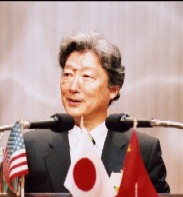��Use of Simulation for
Environmental Earth Protection
- the beginning of simulation culture-��
May 9, 2007
Mr. Tetsuya Sato,
Director-General,
The Earth Simulator Center,
Japan Agency for Marine-Earth Science and Technology
 The front page of the NY Times of April 20, 2002 reported the start of the Earth Simulator (ES) of Japan as ��Computonik is here��.
The front page of the NY Times of April 20, 2002 reported the start of the Earth Simulator (ES) of Japan as ��Computonik is here��.
The Japanese ES project was approved in 1997, the year of the Kyoto IPCC Protocol. The budget to create a super computer to help solve the global warming issue was approved in 1997, and after 5 years of development, operations started in March 2002. The news of this new computer spread around the world. The United States, which is a super power in the field of science and technology, was shocked by being overtaken by Japan, in the same way it was overtaken by the former Soviet Union in space exploration by Sputonik in 1957, and hence reported the Japanese ES as ��Computonik��.
The United States worried deeply that it will be overtaken by Japan not only in academics and technology, but also in industry, the economy and society in general.
The President of the United States ordered to overtake the ES project of Japan and provided the budget to do so. Consequently, at present the United States has surpassed Japan.
Japan��s ES is created by connecting 640 computers in a circle and placing an interconnecting network in the center. Each computer transmits the data it generated to the other computers, and then starts work on the next job. The essence is in the speed of the interconnecting network. Fortunately, the ES was programmed very well and the calculated speed of the ES is around 40 Tflops, and actually runs at around 20 Tflops, which is very fast, and surprised the United States.
Though the calculated speed has been overtaken by other computers and now ranks around 20th in the world, the actually simulation running speed is still regarded as the fastest in the world.
The ES is used 25% by Japanese governmental projects, and 55% are projects selected from the public. Around 30% of the projects are related to meteorology or the environment.
The ES is also open to international projects without compensation, under agreement with 12 international agencies. The 4th IPCC report includes a simulation that global warming was most probably a result of unnatural energy produced by human beings.
Now I will speak on projects regarding predictions of abnormal weather.
Summer heat waves of over 40 degrees centigrade occur every 2 to 3 years in Japan. Through ES, we were able to correctly predict the weather of July 20, 2004, using the data of July 15. Similarly, we simulated the movements of typhoons and the damages from earthquakes etc.
Due to the ES, we are able to predict from the entire global system, whereas in the past we could only gather data on specific areas (such as around Japan), and use theoretical data for other areas, due to lack of memory size and speed. Simulations based on theoretical data cannot correctly predict the workings of global warming, which is affected by the entire global system.
As the ES is based on actual global data, the simulation it produces is useful to the society.
In the past, science, such as a telescope, could only see the world of the past. Using the telescope, we learned how the universe evolved. But the telescope could not predict the future, and the future was left to the field of science fiction. With the ES, we have gained a telescope to investigate the future.
An important step after creating a high-grade computer is to create the algorithm for the simulation, which depends on the knowledge of scientists.
Since simulation of the entire global data is not possible, due to the vast three-dimensional space, we have decided to separately simulate micro and macro data, and exchange the two data.
For example, we will simulate the movements of a typhoon for the entire earth in blocks of 3 to 5 km. At the same time we will focus on the eye of the typhoon and investigate how the clouds form, and predict rain movements etc.
In this way, ES has enabled us to gain answers to micro and macro data of the earth.